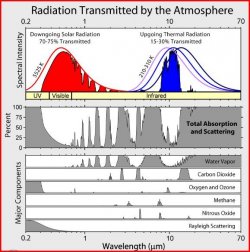SSDD
Gold Member
- Nov 6, 2012
- 16,672
- 1,966
- 280
The process of CO2 absorbing a photon and emitting a photon are mirrored. Show us a valid source which states emission and absorption take place at different frequencies because it looks to me as if you're attempting to violate Kirchoff's Law of Thermal Radiation
Is it your claim that it requires zero energy to excite a molecule to a higher energy state so that it emit's a photon? Is that really your claim...and if you acknowledge that some small bit of energy is required to accomplish that task...how do you suppose the photon is emitted at the same frequency as it was emitted?

